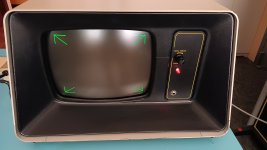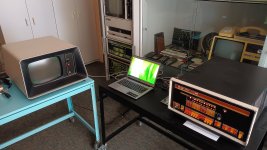thunter0512
Veteran Member
After running my newly built VC8E in my PDP-8/e beautifully displaying on a VR14 sadly the fun suddenly came to an end. 
The 3A line fuse of the VR14 had blown and of course the replacement fuse blew immediately too.
After some probing with a multimeter I found that the +/-22V power supply's "bridge rectifier" made up of two chassis mounted DM-15 diode modules had a shorted diode.
I replaced the two DM-15 modules with a single modern bridge rectifier and the 3A line fuse was happy again.
Unfortunately the +/-22V rails were now around +/-34V.
I turns out that the 2N4399 & 2N5302 power transistors in the power supply are all shorting. I am sure that there is an underlying cause for all this trouble. At this point everything is suspect.
The 2N4399 and 2N5302 transistors are no longer readily available, but staff at the Living Computer Museum (LCM) in Seattle have written a blog where they recommend to replace these transistors with higher spec-ed 2N5684G and 2N5686G.
These newer more powerful transistors are still available but rather expensive. I need at least 4 of each to replace all the power transistors in both the power supply and X/Y amplifiers.
The prices I found are:
It is very likely that due to another yet unidentified fault these die immediately too, so the repair cost quickly escalates. I think these expensive transistors are acting as fuses for something else.
Any suggestions on how to proceed?
Also is there a cheap source for either the original (2N4399 and 2N5302) transistors or the replacements suggested by the LCM (2N5684G and 2N5686G)?
Thanks
Tom
The 3A line fuse of the VR14 had blown and of course the replacement fuse blew immediately too.
After some probing with a multimeter I found that the +/-22V power supply's "bridge rectifier" made up of two chassis mounted DM-15 diode modules had a shorted diode.
I replaced the two DM-15 modules with a single modern bridge rectifier and the 3A line fuse was happy again.
Unfortunately the +/-22V rails were now around +/-34V.
I turns out that the 2N4399 & 2N5302 power transistors in the power supply are all shorting. I am sure that there is an underlying cause for all this trouble. At this point everything is suspect.
The 2N4399 and 2N5302 transistors are no longer readily available, but staff at the Living Computer Museum (LCM) in Seattle have written a blog where they recommend to replace these transistors with higher spec-ed 2N5684G and 2N5686G.
These newer more powerful transistors are still available but rather expensive. I need at least 4 of each to replace all the power transistors in both the power supply and X/Y amplifiers.
The prices I found are:
- 2N5684G: US$15.89
- 2N5686G: US$21.20
It is very likely that due to another yet unidentified fault these die immediately too, so the repair cost quickly escalates. I think these expensive transistors are acting as fuses for something else.
Any suggestions on how to proceed?
Also is there a cheap source for either the original (2N4399 and 2N5302) transistors or the replacements suggested by the LCM (2N5684G and 2N5686G)?
Thanks
Tom


